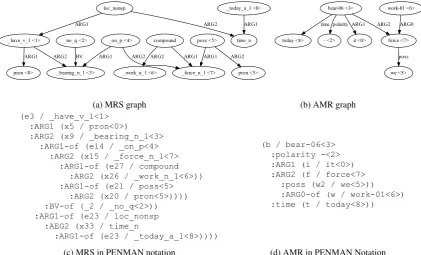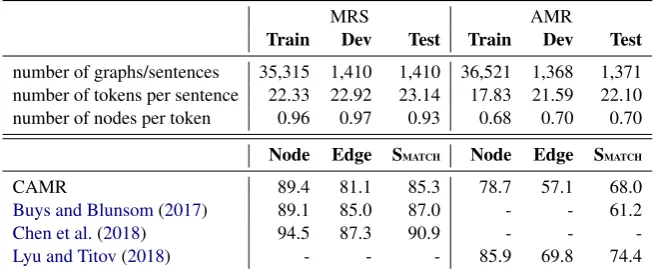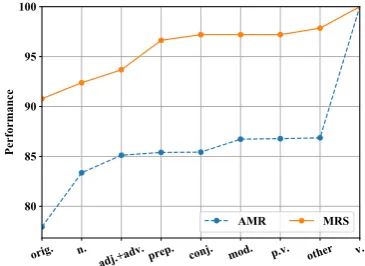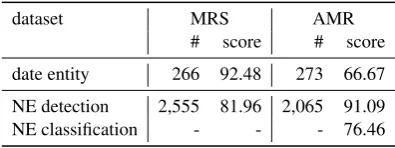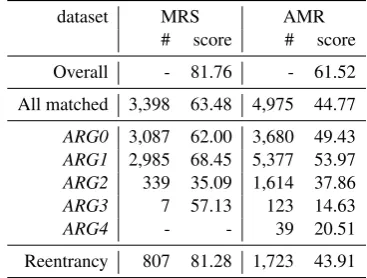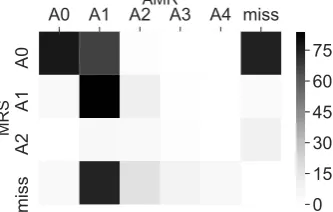Proceedings of the First International Workshop on Designing Meaning Representations, pages 34–43 34
Parsing Meaning Representations: is Easier Always Better?
Zi Lin∗
Peking University
zi.lin@pku.edu.cn
Nianwen Xue
Brandeis University
xuen@brandeis.edu
Abstract
The parsing accuracy varies a great deal for different meaning representations. In this paper, we compare the parsing perfor-mances between Abstract Meaning Represen-tation (AMR) and Minimal Recursion Seman-tics (MRS), and provide an in-depth analy-sis of what factors contributed to the discrep-ancy in their parsing accuracy. By crystaliz-ing the trade-off between representation ex-pressiveness and ease of automatic parsing, we hope our results can help inform the design of the next-generation meaning representations.
1 Introduction
Meaning representation (MR) parsing is the task of parsing natural language sentences into a formal representation that encodes the meaning of a sen-tence. As a matter of convention in the field of nat-ural language processing, meaning representation parsing is distinguished from semantic parsing, a form of domain-dependent parsing that analyzes text into executable code for some specific appli-cations. Earlier work in semantic parsing focused on parsing natural language sentences into seman-tic queries that can be executed against a knowl-edge base to answer factual questions (Wong and Mooney, 2006; Kate and Wong, 2010; Berant et al.,2013;Artzi and Zettlemoyer,2013). More recently, this line of work has been extended to parsing natural language text into computer pro-grams (Ling et al.,2016;Yin and Neubig,2017) and parsing tabular information in texts. Here we focus on the parsing of natural language sentences into domain-independent MRs that are not geared towards any one particular application, but could be potentially useful for a wide range of applica-tions.
∗
Work done during the internship at Brandeis University.
The challenge for developing a general-purpose meaning representation is that there is not a uni-versally accepted standard and as a result, existing MRs vary a great deal with respect to which as-pects of the linguistic meaning of a sentence are included and how they are represented. For exam-ple, existing MRs differ in whether and how they represent named entities, word sense, coreference, and semantic roles, among other meaning compo-nents.
These design decisions have consequences for the automatic parsing of these MRs. Among two of the meaning representations for which large-scale manual annotated data exist, the state-of-the-art parsing accuracy for AMR is generally in the high 60s and low 70s (May, 2016; May and Priyadarshi, 2017), while state-of-the-art parsing accuracy for (variations of) MRS is in the high 80s and low 90s (Oepen et al.,2014). Little has been done thus far to investigate the underlying causes for this rather large discrepancy. For pur-poses of developing the next generation MRs, it is important to know i) which aspects of the MR pose the most challenge to automatic parsing and ii) whether these challenges are “necessary evils” because the information encoded in the MR is im-portant to downstream applications and has to be included, or they can be simplified without hurting the utility of the MR.
parser we use is CAMR (Wang et al., 2015a,b), a transition-based parser originally developed for AMR that we adapt to MRS. To make CAMR as well as SMATCH work on MRS data, we rewrote the native MRS data in PENMAN notation. Ide-ally, the parser needs to be trained on the same source text annotated with these two MRs to iso-late the contributions of the MR from other fac-tors, but this is not currently possible, so we fall back on the next best thing, and use data sets an-notated with AMR and MRS that are similar in size.
Our experimental results show that the SMATCH score for MRS parsing is almost 20% higher than that for AMR. A detailed comparative analysis of the parsing results reveals that the main contributing factors into the lower parsing accuracy for AMR are the following:
• AMR concepts show a higher level of ab-straction from surface forms, meaning that AMR concepts bear less resemblance to the word tokens in the original sentence.
• AMR does a much more fine-grained clas-sification for the named entities than MRS, which contributes to errors in concept identi-fication.
• Semantic relations are defined differently in AMR and MRS. While in AMR a semantic role represents a semantic relation between a verbal or nominal predicate and its argument, in MRS the predicate can also be a prepo-sition, adjectives, or adverbs. Another dif-ference is that while in AMR, the semantic roles for the core arguments of a predicate are interpretable with respect to an external lex-icon, the semantic roles in MRS reflect the level of obliqueness and are linked to an ex-ternal lexicon.1
We hope that by clearly identifying aspects of the MR that contributed to the challenges in au-tomatic meaning representation parsing, we can help researchers make more informed decisions on
1
These do not necessarily account for all the factors that might contribute to the discrepancy in performance between the two meaning representations. As one reviewer points out, the lack of manual alignment between word tokens in a sen-tence and the concepts in its AMR graph may also have con-tributed to challenge in parsing AMRs. Annotation consis-tency in the data set may also be a contributing factor. There are no obvious way to quantify these factors and we leave these to future research.
the trade-off between representation expressive-ness and ease of automatic parsing when develop-ing the next-generation MRs.
The rest of the paper is organized as follows: Section 2 briefly describes the key elements of MRS and AMR; Section3reports our experiment setup and main parsing results for the two MRs; Section 4 provides a detailed analysis of the im-pacts of different aspects of the MR on automatic parsing. Section5concludes the paper.
2 Meaning Representations
In this section, we provide a brief description of the meaning representations that we investigate, Minimal Recursion Semantics (MRS) and Ab-stract Meaning Representation (AMR). Both MRs can be visualized as a graph with labeled nodes and edges. Figure 1 shows the MRS and AMR representations for the sentence “it has no bearing on our work force today”, which we will use to illustrate the various aspects of the two meaning representation frameworks.
2.1 Minimal Recursion Semantics
MRS serves as the logical-form semantic rep-resentation of the English Resource Grammar (ERG;Flickinger,2000)2, a broad-coverage gram-mar of English and an implementation of the grammatical theory of Head-driven Phrase Struc-ture Grammar (HPSG; Pollard and Sag, 1994). For our experiments, we use a variation of MRS called Elementary Dependency Structures (EDS; Oepen and Lønning, 2006), which retains the structural aspect of MRS that is of interest to us but excludes the morpho-syntactic features and the (underspecified) scopal information.
As can be seen from Figure 1a, nodes in an MRS representation are labeled with semantic predicates (e.g. bearing n 1andcompound). MRS makes the distinction between surface and abstract predicates. A surface predicate consists of a lemma followed by (1) a coarse part-of-speech tag and (2) an optional sense label, which can be a number indicating the sense ID, a particle in the verb-particle construction (e.g., look up), or a case-marking prepositions (e.g., rely on). Exam-ples of surface predicates are illustrated below:
• look v 1: Look how much air is moving around!
_have_v_1 <1>
pron <0> ARG1
_bearing_n_1 <3> ARG2
_on_p <4> ARG1
_force_n_1 <7> ARG2
compound ARG1 _work_n_1 <6>
ARG2
poss <5> ARG1
pron <5> ARG2 _no_q <2>
BV
loc_nonsp ARG1
time_n ARG2
_today_a_1 <8> ARG1
(a) MRS graph
bear-06 <3>
it <0> ARG1 - <2>
polarity
force <7> ARG2 today <8>
time
we <5> poss work-01 <6>
ARG0
(b) AMR graph (e3 / _have_v_1<1>
:ARG1 (x5 / pron<0>)
:ARG2 (x9 / _bearing_n_1<3> :ARG1-of (e14 / _on_p<4>
:ARG2 (x15 / _force_n_1<7> :ARG1-of (e27 / compound
:ARG2 (x26 / _work_n_1<6>)) :ARG1-of (e21 / poss<5>
:ARG2 (x20 / pron<5>)))) :BV-of (_2 / _no_q<2>)) :ARG1-of (e23 / loc_nonsp
:AEG2 (x33 / time_n
:ARG1-of (e23 / _today_a_1<8>))))
(c) MRS in PENMAN notation
(b / bear-06<3> :polarity -<2> :ARG1 (i / it<0>) :ARG2 (f / force<7>
:poss (w2 / we<5>)) :ARG0-of (w / work-01<6>) :time (t / today<8>))
[image:3.595.77.499.76.331.2](d) AMR in PENMAN Notation
Figure 1: The graphs and PENMAN notations of MRS and AMR for the sentence “it<0>has<1>no<2> bear-ing<3>on<4>our<5>work<6>force<7>today<8>” (Fromwsj 0003 30).
• look v up: Researchers can look up credit ratings, and even question neighbors.
• rely v on: We’ll rely very much on their leadership.
No lexical item can be associated with multi-ple surface predicates in MRS, but some lexical items bring abstract predicates, which is distin-guished with no leading underscore. For example, in Figure1a, the pronouns represented uniformly aspron, thecompound(compoundingworkand
force),loc nonsp (an implicit locative without a specific preposition), andtime ndecomposing the lexical itemtimeare abstract predicates3.
The edges in an MRS graph are labeled with a small set of roles that indicate the relation between a predicate and its argument (e.g., ARG1, ARG2) or between a predicate and a quantifier (e.g., BV). These roles are used to provide a numerical ID for the arguments of a predicate that occur in a sen-tence, and they are not interpretable with respect to an external taxonomy or valency lexicon. As a result, these numerical IDs are ordered and con-secutive and it is not possible to have an ARG3 without anARG1and anARG2. In general,ARG1
3For more details of the abstract predicates, please see:
http://moin.delph-in.net/ErgSemantics/ Basics
always corresponds to the first (least oblique) ar-gument,ARG2the second (next least oblique) ar-gument, and so on.
2.2 Abstract Meaning Representation
AMR represents the meaning of a sentence as a rooted, labeled, directed, and acyclic graph (DAGs), as illustrated in Figure1b. The nodes in an AMR graph are annotated with AMR concepts, which can also be concrete (surface) or abstract. A concrete concept is “evoked” by one or more lex-ical items in the sentence, while an abstract con-cept is inferred from a particular semantic context. A concrete concept can be a sense-tagged predi-cate (e.g., “bear-06” in Figure1b) drawn from the Propbank (Palmer et al., 2005), or the lemma of a word in the sentence (e.g., “force” in Figure1b. In general, only predicates that can be found in the PropBank frame files have their senses defined and annotated in AMR. Here are the four senses de-fined for the verb “bear” (excluding phrasal verbs)
• bear-01: hold, support, endure. • bear-02: bear children.
• bear-03: move
• bear-06: has relation to
sur-face lexical units and as we will show in Section4, this is one aspect of AMR that poses a great deal of challenge to automatic parsing. For example, the modal verb “can” corresponds to the AMR con-cept “possible”. There are also other cases where a concept corresponds to a morpheme instead of the entire word. For example, the word “investor” is analyzed as
(p / person
:ARG-of (i / invest-01))
and the concept “person” corresponds to the suffix “-or”.
In addition to concrete concepts, AMR also has abstract concepts that do not correspond to any lexical unit. For example, the concept “have-org-role-91” can be inferred from just the phrase “U.S. President Obama” as it implies that a person named “Obama” holds the position of the “presi-dent” in the organization that is the U.S. govern-ment:
(p / person
:name (n / name :op1 "Obama") :ARG0-of (h / have-arg-role-91
:ARG1 (c / country :name (n2 / name
:op1 "US")) :ARG2 (p2 / president)))
The edges in an AMR graph are annotated with AMR relations, most of which can be viewed as semantic roles an argument plays with respect to its predicate. Although the naming convention of the semantic roles defined for the core arguments of a predicate in AMR is very similar to that used in MRS — both use an integer prefixed by “Arg” (e.g., ARG0, ARG1), that’s where the similarity ends. Unlike MRS, the semantic role for each core argument is defined for a specific sense of a predicate in the PropBank frame files, and can thus be interpreted. For example, for the predicate bear-06, the semantic roles for the core argu-ments are:
• ARG1:topic • ARG2:related topic
In addition to the semantic roles for the core ar-guments, AMR uses a rather large set of semantic relations for non-core arguments. The semantic relations not tied to a specific predicate and in-clude MANNER, TIME, DEGREE, etc. In total, there are 83 AMR relations.
3 Data preparation and parsing results
3.1 Data Preparation
We conduct the experiments on the dataset SDP20154 for MRS parsing and LDC2016E255 for AMR parsing. We use the PENMAN nota-tion as the serializanota-tion format for both AMR and MRS. The PENMAN notation is the native format for the AMR data set, and we convert the MRS data to the PENMAN notation using the pyDel-phin library. We use the training/development/test splits as recommended in the dataset releases. Some key statistics of the two data sets are pre-sented in the top half of Table1.
As we can see from the table, the number of sentences/graphs in the two data sets is similar in size, and this is important for purposes of compar-ing the parser performance on the two data sets. The number of nodes per token in MRS is much greater than that in AMR, this is mainly due to (1) the large number of abstract nodes in MRS and (2) the fact that the MRS concepts are much closer to the surface form than AMR (e.g., AMR does not have node representation for determin-ers, the infinitive marker “to”, prepositions that introduce oblique arguments and etc, while for the most cases, MRS does encode information for these function words).
3.2 Choosing a parsing model
Many parsers have been developed recently ei-ther for AMR parsing (Lyu and Titov, 2018; Groschwitz et al.,2018;Guo and Lu,2018;Dozat and Manning,2018;Wang et al.,2018;Wang and Xue, 2017; Wang et al., 2015a; Flanigan et al., 2014) or MRS parsing (Chen et al., 2018) , but relatively few parsers are capable of parsing both MR formalisms (Buys and Blunsom, 2017). To compare parsing results on MRS and AMR us-ing the same parsus-ing model, we need a parser that can parse another MR with minimal adaptation. In our experiment, we use CAMR, a transition-based parser6(Wang et al.,2015a) originally developed for AMR parsing that we also adapt to MRS pars-ing.
CAMR performs MR parsing in two steps. The first step is to parse a sentence into a dependency
4
http://sdp.delph-in.net/2015/data. html
5
https://catalog.ldc.upenn.edu/ LDC2016E25
MRS AMR
Train Dev Test Train Dev Test
number of graphs/sentences 35,315 1,410 1,410 36,521 1,368 1,371 number of tokens per sentence 22.33 22.92 23.14 17.83 21.59 22.10 number of nodes per token 0.96 0.97 0.93 0.68 0.70 0.70
Node Edge SMATCH Node Edge SMATCH
CAMR 89.4 81.1 85.3 78.7 57.1 68.0
Buys and Blunsom(2017) 89.1 85.0 87.0 - - 61.2
Chen et al.(2018) 94.5 87.3 90.9 - -
[image:5.595.136.465.63.199.2]-Lyu and Titov(2018) - - - 85.9 69.8 74.4
Table 1: Statistics and parsing results for MRS and AMR on the test set
tree with an off-the-shelf parser, and the second step is to transform the dependency tree into the target MR graph by performing a series of actions each of which changes a parsing state to a new state. SeeWang et al.(2015b,a) for details on how CAMR works.
As we described in Section 2, both AMR and MRS abstract away from the surface lexical units and the nodes in the MR graph are not simply word tokens in the sentence. In order to train CAMR, the word tokens in the sentence need to be aligned with nodes in the meaning representation graph to the extent that is possible. The MRS data comes with manual alignments, but the AMR data set does not, so we utilize the automatic aligner in JAMR(Flanigan et al.,2014) to align the word to-kens in the sentence with nodes in the AMR graph.
In our experiment, we use the Stanford CoreNLP toolkit (Manning et al., 2014) to pro-duce the dependency structure that we use as in-put to CAMR. We also use this toolkit to pro-duce part-of-speech tags and name entity infor-mation for use as features. Considering the need for cross-framework MR parsing, we do not make use of a semantic role labeler as the original CAMR does, as semantic role labeling is irrele-vant to MRS parsing. This hurts the AMR parsing somewhat but not by too much. When adpating CAMR to MRS, we perform the following post-processing steps: (1) changing the AMR-style naming convention for named entities name and :op to MRS-style named (or other date-entity nodes) and:carg; (2) if the word is unknown to the parser, copying the lemma and the predicted POS tag to form an “unknown word”; (3) dis-abling the functionality for classifying named enti-ties; (4) adding the abstract node “nominalization” if a predicate has been nominalized.
3.3 Parsing Results
The results based on the SMATCH score (Cai and Knight,2013) are reported in Table1. We also in-clude the state-of-the-art parsers for each frame-work (an SHRG-based parser for MRS (Chen et al., 2018) and a neural AMR parser (Lyu and Titov,2018)) as well as a cross-framework neural parser inBuys and Blunsom(2017). For CAMR, the gap in F1 between the two frameworks is 17.3% and the difference is larger for Buys and Blunsom(2017), which is more than 20%.
4 What makes AMR parsing difficult?
To investigate which aspects of the MRs contribute to the large gap in performance between AMR and MRS parsing, we perform a detailed examination of different aspects of the meaning representation parsing process.
4.1 Concept Detection
The first step in constructing a meaning represen-tation graph is concept identification, or determin-ing the nodes of the meandetermin-ing representation graph. As should be clear from our description in Section 2, the concepts in an AMR or MRS graph abstract away from the surface lexical units in a sentence, and as a result, it is non-trivial to predict the con-cepts in a meaning representation graph based on the word tokens in a sentence. This process can be as simple as performing lemmatization, but it can also be as complicated as performing word sense disambiguation or even inferring abstract concepts that do not correspond to a particular word token.
MRS
POS % #lemma #sense average score WSD
n 34.46 1,420 1,434 1.01 95.35 99.76 v 20.37 838 1,010 1.21 85.56 90.58
q 13.97 25 25 1.00 98.22 100.00
p 12.86 96 123 1.28 81.29 76.11
a 11.45 637 648 1.02 90.58 99.90
c 4.20 17 19 1.12 94.46 99.61
x 2.69 80 81 1.01 73.65 99.74
total 100.00 3,113 3,340 1.07 90.78 97.06 AMR
[image:6.595.75.288.62.195.2]pred - 1,292 1,440 1.11 77.93 94.54
Table 2: Node identification and WSD results on MRS in terms of noun (n), verb (v), quantifier (q), preposi-tion (p), adjective (a), conjuncpreposi-tion (c), and others (x), and on AMR in terms of predicate (pred). Both are measured on the test set in terms of accuracy based on SMATCH.
performed on verbal, nominal and other predi-cates. For MRS parsing, word sense disambigua-tion needs to be performed all the concepts that are not constants (number, date and named entities) or abstract concepts (compound,subord, etc.).
Table 2 reports the accuracy based on the SMATCH for concept detection in general7, and concepts that requires word sense disambiguation to identify on the test set. We also present a con-cept detection accuracy breakdown by the part of speech of the words that they are aligned to. As we can see from the table, the overall concept detec-tion accuracy is much lower for AMR than MRS. However, for concepts that involve word sense dis-ambiguation, the difference is rather small, indi-cating that word sense disambiguation is not a ma-jor contributor in the performance gap.
Concept abstraction Now that we have estab-lished that word sense disambiguation is not a ma-jor contributor to the difficulty in concept detec-tion for AMR parsing, we take a closer look at how concept detection fared for lexical categories that are known to have a complex mapping to the con-cepts they “evoke”. For lack of a better term, we call this “concept abstraction”. We will examine how abstraction of verbs (v.), nouns (n.), adjectives (adj.), adverbs (adv.), prepositions (prep.), con-junctions (conj.), phrasal verbs (p.v.) and modal verbs (mod.) impact concept detection accuracy.
• Phrasal verbs AMR tends to normalize phrasal verbs to single verbs where possible.
7The accuracy is calculated between the gold and the parsed graphs, regardless of the alignment to surface sub-strings.
RULJ Q
DGMDGYSUHS FRQM PRG SY RWKHU Y
3HUIRUPDQFH
[image:6.595.324.507.63.196.2]$05 056
Figure 2: Relative improvement of performance on the test set after correcting each type of POSs or construc-tions in AMR
For example, the same predicatebathe-01 is used for both “take a bath” and “bathe”.
• Nouns. The verb and its nominalization often share the same predicate in AMR. For exam-ple, the predicate for both “destruction” and “destroy” isdestroy-01.
• Adjectives. Like nouns, an adjectival pred-icate is normalized to the same form as that of its verbal counterpart if the adjective is de-rived from a verb. For example, the predicate for “attractive” isattract-01. This obvi-ously does not apply adjectives like “quick” and “tall”, which do not have a verbal coun-terpart.
• Adverbs with the suffix -ly. The Predicate of an adverb is often normalized to its adjec-tival form. For example, for both “quickly” and “quick”, the predicate isquick-01.
• Prepositions. Most prepositions do not map to a concept in AMR except for idiomatic constructions such as “out of mind”, whose predicate isout-06.
• Conjunctions. The concepts for coordinat-ing conjunctions can be very different from their surface form. For example, the concept for “but” isconstrast-01.
type n. adj. adv. prep. conj. mod. p.v. other v.
[image:7.595.141.460.64.104.2]% 35.09 10.05 1.87 1.17 1.01 2.59 0.31 0.15 47.76 Performance 83.01 84.44 80.73 73.53 96.61 66.96 83.33 44.44 74.07
Table 3: Individual percentage and score for different types of AMR’s predicates
Entity type Example AMR MRS
calendar lunar calendar (d / date-entity :calendar (m / moon))
-month December (8th) (d / date-entity :month 12) (x1 / mofy :carg "Dec") weekday Monday (d / date-entity :weekday (m / monday)) (x1 / dofw :carg "Mon") day (December) 8th (d / date-entity :day 8) (x1 / dofm :carg "8") dayperiod night (d / date-entity :dayperiod (n / night))
-named entity New York
(c1 / city
:name (n1 / name
:op1 "New" :op2 "York"))
(x1 / named :carg "York"
:ARG1-of (e1 / compound
:ARG2 (x2 / named :carg "New")))
Table 4: Date-entity of AMR and MRS. Thecargin MRS means “constant argument”, which takes as its value a string representing the name of the entity.
To identify the lexical categories or construc-tions that evoke the concepts, we first extract words or word sequences that are aligned with these concepts, and then use a set of heuristics based on morpho-syntactic patterns to determine the exact type of abstraction in the test set. We measure the improvement in concept detection ac-curacy if concepts for each additional category are correctly detected. If there is a big improvement in accuracy if we assume the concepts are correctly detected for that category, that means concept de-tection for that category is a big challenge. The ac-curacy will remain unchanged if the type is unde-fined for that MR (e.g.p.v.for MRS). MRS labels most of the adverbs as its corresponding adjective form, so we merge these two types together.
The individual result is reported in Table3and the improvement is illustraed in Figure 2, which shows that concept detection accuracy in AMR is mainly dragged down by nouns and verbs due to their relatively large proportions. While preposi-tions play an important role in concept detection in MRS, most prepositions do not map to concepts in AMR and thus do not contribute to the errors in AMR concept detection.The concept detection for modal verbs is also difficult for AMR but not for MRS.
Named and date entities We next examine how well entities are detected in AMR and MRS pars-ing. Named and date entities are typically multi-Word expressions (MWEs) that do not have a sim-ple mapping between the word tokens in a sen-tence and the concepts in a meaning representa-tion graph. In AMR, date entities are mapped to a date-entity concept with an attribute that
indicates the specific type of entity. Named enti-ties are mapped to anameconcept with a detailed classification of the named entity type (e.g.,city, country). AMR defines 124 total entity types, a very fine-grained classification. In MRS, date en-tities map to a date entity type (“season”) with an attribute that is a constant (“winter”). Named en-tities are treated as a type of a compound that has anamedconcept as its argument. MRS does not provide a detailed classification of named en-tities. More examples of AMR and MRS date (the first five rows) and named entities (the last row) are provided in Table4.
dataset MRS AMR
# score # score
date entity 266 92.48 273 66.67
NE detection 2,555 81.96 2,065 91.09 NE classification - - - 76.46
Table 5: Results on entity recognition on the test set
[image:7.595.318.516.475.549.2]:calendar (m / moon)). For named enti-ties while the named entity detection accuracy is higher for AMR than MRS, but since AMR pars-ing also requires named entities be correctly clas-sified, overall correctly parsing named entities in AMR is still much harder.
4.2 Relation Detection
In this section, we consider the subtask of rela-tion detecrela-tion in meaning representarela-tion parsing, which involves identifying and labeling the edges in the meaning representation graph. We focus on Semantic Role Labeling (SRL) of the core argu-ments, arguments that receive the label ARG-i, whereiis an integer that ranges from 0 to 5. In or-der to isolate the effect of SRL, we only consior-der cases where the concepts (nodes) have been cor-rectly detected. The results on the test set are pre-sented in Table6. The overall results are based on the SRL smatch computed on:ARG-i roles us-ing the toolkitamr-eager8. Here “all matched” refers to complete match, i.e., the predicted sub-graph rooted in the predicate9match the gold sub-graph. Note that both MRS and AMR graphs con-tain reentrancy, meaning that the same concept can participate in multiple relations, so we also include a separate evaluation of reentrancy.
As we can see, the accuracy for both SRL in general and reentrancy in particular is much lower for AMR than MRS, and the number of re-entrancies is much greater for AMR than MRS.
10 A closer look reveals that the main cause for
the difference in performance lies in the different ways of how MRS and AMR represent the prepo-sitional phrases and coreferene, as well as how the semantic roles are defined for the two MRs.
Prepositional phrases MRS treats prepositions as predicates, and labels their arguments, while AMR just drops the preposition when it introduces an oblique argument for a verbal predicate so the object of the preposition becomes an argument of the verbal predicate, resulting in non-local
rela-8
https://github.com/mdtux89/amr-eager
9For MRS we only count the verbs, so the number of pred-icates and arguments is much greater for AMR than MRS.
10
This may seem to contradict the observation in
Kuhlmann and Oepen (2016) where they show MRS has more re-entrancies than AMR. This is because in our experi-ments we removed the edge linking a conjunction to its con-junct to remove the cycles that would have a negative impact on parsing accuracy but do not offer further information. This accounts for most of the re-entrancies in the EDS variant of MRS.
dataset MRS AMR # score # score
Overall - 81.76 - 61.52
All matched 3,398 63.48 4,975 44.77
ARG0 3,087 62.00 3,680 49.43 ARG1 2,985 68.45 5,377 53.97 ARG2 339 35.09 1,614 37.86 ARG3 7 57.13 123 14.63 ARG4 - - 39 20.51
[image:8.595.324.508.63.202.2]Reentrancy 807 81.28 1,723 43.91
Table 6: Results on SRL. MRS’s argument number be-gins at1so we just move all the argument to begin at0
to make them comparable.
tions. This explains why SRL is more difficult for AMR than MRS, illustrated in the top example in Figure3, where there are different representations for the prepositional phrase in the sentence. The MRS design choice, in this case, leads to more structures to predict, compared with just one struc-ture in AMR. Assuming these sub-graphs are com-paratively easy to predict, this may contribute to higher scores in MRS parsing.
Coreference AMR resolves sentence-level coreference, i.e., if there is more than one ex-pression in the sentence referring to the same entity, that entity will be an argument for all the predicates that it is an argument of. In contrast, MRS does not resolve coreference and each instance of the same entity will be a separate concept in the MRS graph. This is illustrated in bottom example in Figure 3. The labeled arguments for the predicate “eat” in the two MRs are totally different but actually they refer to the same entities. Not having to do coreference resolution makes MRS parsing easier and this also explains the lower SRL accuracy for AMR.
The exports increased 4% from the same period to $50.45 billion.
ARG1 ARG2
ARG3
ARG4
ARG0
ARG0
ARG1
ARG0 ARG1 loc nonsp
Knowing a tasty meal when they eat one, the executives gave the chefs a standing ovation.
ARG0
ARG1
[image:9.595.79.523.62.168.2]ARG1 ARG0
Figure 3: The SRL representations of MRS (edge above) and AMR (edge below) for the sentences “the exports increased 4% from the same period to $50.45 billion” and “knowing a tasty and free meal when they eat one, the executives gave the chefs a standing ovation”. Forincrease-01, PropBank defines theARG0andARG1as “cause of increase” and “thing increasing”, so “the exports” here will be labeled asARG1instead ofARG0.
A0 A1 A2 A3 A4 missAMR
A0
A1
A2
miss
MRS
0 15 30 45 60 75
Figure 4: Confusion matrix between MRS and AMR
much higher (F1 = 77.83). The low labeled agreement can be explained by the different ways of how semantic roles are defined. We illustrate this difference using the confusion matrix in Fig-ure 4. The numeric value of the semantic roles tends to be smaller in MRS than in AMR. As dis-cussed in Section 2, while the semantic roles in MRS represent the level of obliqueness of argu-ments realized in a particular sentence, the seman-tic roles in AMR are defined for theexpected ar-gumentsof a predicate in an external lexicon that is independent of any particular sentence. The se-mantic roles for the arguments that actually occur in a particular sentence may be discontinuous in a particular context, making them more difficult to predict.
5 Conclusion
In this work, we evaluated the similarities and dif-ferences in the semantic content encoded by Min-imal Recursion Semantics (MRS) and Abstract Meaning Representation (AMR). After parsing the two MRs using the same parser and evaluating them using the same metric, we provide a detailed analysis of the differences between the two MRs in both substance and style that leads to a large
gap in automatic parsing performance. In doing so, we help crystalize the trade-off between rep-resentation expressiveness and ease of automatic parsing and hope this study will inform the design and development of next-generation MRs.
Acknowledgement
We thank the anonymous reviewers for their help-ful comments, and Junjie Cao for discussing the details of meaning representations with us. This work is supported by a grant from the IIS Divi-sion of National Science Foundation (Award No. 1763926) entitled “Building a Uniform Meaning Representation for Natural Language Processing” awarded to the second author. All views expressed in this paper are those of the authors and do not necessarily represent the view of the National Sci-ence Foundation.
References
Yoav Artzi and Luke Zettlemoyer. 2013. Weakly su-pervised learning of semantic parsers for mapping instructions to actions. Transactions of the Associa-tion for ComputaAssocia-tional Linguistics, 1:49–62.
Jonathan Berant, Andrew Chou, Roy Frostig, and Percy Liang. 2013. Semantic parsing on freebase from question-answer pairs. In Proceedings of the 2013 Conference on Empirical Methods in Natural Lan-guage Processing, pages 1533–1544.
Jan Buys and Phil Blunsom. 2017. Robust incremen-tal neural semantic graph parsing. arXiv preprint arXiv:1704.07092.
[image:9.595.97.264.249.355.2]Yufei Chen, Weiwei Sun, and Xiaojun Wan. 2018. Ac-curate shrg-based semantic parsing. In Proceed-ings of the 56th Annual Meeting of the Association for Computational Linguistics (Volume 1: Long Pa-pers), pages 408–418, Melbourne, Australia. Asso-ciation for Computational Linguistics.
Timothy Dozat and Christopher D Manning. 2018. Simpler but more accurate semantic dependency parsing.arXiv preprint arXiv:1807.01396.
Jeffrey Flanigan, Sam Thomson, Jaime Carbonell, Chris Dyer, and Noah A Smith. 2014. A discrim-inative graph-based parser for the abstract meaning representation. InProceedings of the 52nd Annual Meeting of the Association for Computational Lin-guistics (Volume 1: Long Papers), volume 1, pages 1426–1436.
Dan Flickinger. 2000. On building a more effcient grammar by exploiting types. Natural Language Engineering, 6(1):15–28.
Jonas Groschwitz, Matthias Lindemann, Meaghan Fowlie, Mark Johnson, and Alexander Koller. 2018. Amr dependency parsing with a typed semantic al-gebra. arXiv preprint arXiv:1805.11465.
Zhijiang Guo and Wei Lu. 2018. Better transition-based amr parsing with a refined search space. In
Proceedings of the 2018 Conference on Empirical Methods in Natural Language Processing, pages 1712–1722.
Rohit J Kate and Yuk Wah Wong. 2010. Semantic pars-ing: The task, the state of the art and the future. Tu-torial Abstracts of ACL 2010, page 6.
Marco Kuhlmann and Stephan Oepen. 2016. Towards a catalogue of linguistic graph banks. Computa-tional Linguistics, 42(4):819–827.
Wang Ling, Edward Grefenstette, Karl Moritz Her-mann, Tom´aˇs Koˇcisk`y, Andrew Senior, Fumin Wang, and Phil Blunsom. 2016. Latent predic-tor networks for code generation. arXiv preprint arXiv:1603.06744.
Chunchuan Lyu and Ivan Titov. 2018. Amr parsing as graph prediction with latent alignment. arXiv preprint arXiv:1805.05286.
Christopher Manning, Mihai Surdeanu, John Bauer, Jenny Finkel, Steven Bethard, and David McClosky. 2014. The stanford corenlp natural language pro-cessing toolkit. In Proceedings of 52nd annual meeting of the association for computational lin-guistics: system demonstrations, pages 55–60.
Jonathan May. 2016. Semeval-2016 task 8: Mean-ing representation parsMean-ing. In Proceedings of the 10th international workshop on semantic evaluation (semeval-2016), pages 1063–1073.
Jonathan May and Jay Priyadarshi. 2017. Semeval-2017 task 9: Abstract meaning representation pars-ing and generation. In Proceedings of the 11th International Workshop on Semantic Evaluation (SemEval-2017), pages 536–545.
Stephan Oepen, Marco Kuhlmann, Yusuke Miyao, Daniel Zeman, Dan Flickinger, Jan Hajic, Angelina Ivanova, and Yi Zhang. 2014. Semeval 2014 task 8: Broad-coverage semantic dependency parsing. In
Proceedings of the 8th International Workshop on Semantic Evaluation (SemEval 2014), pages 63–72.
Stephan Oepen and Jan Tore Lønning. 2006. Discriminant-based mrs banking. In LREC, pages 1250–1255.
Martha Palmer, Daniel Gildea, and Paul Kingsbury. 2005. The proposition bank: An annotated cor-pus of semantic roles. Computational linguistics, 31(1):71–106.
Carl Pollard and Ivan A Sag. 1994. Head-driven phrase structure grammar. University of Chicago Press.
Chuan Wang and Nianwen Xue. 2017. Getting the most out of amr parsing. In Proceedings of the 2017 conference on empirical methods in natural language processing, pages 1257–1268.
Chuan Wang, Nianwen Xue, and Sameer Pradhan. 2015a. Boosting transition-based amr parsing with refined actions and auxiliary analyzers. In Proceed-ings of the 53rd Annual Meeting of the Association for Computational Linguistics and the 7th Interna-tional Joint Conference on Natural Language Pro-cessing (Volume 2: Short Papers), volume 2, pages 857–862.
Chuan Wang, Nianwen Xue, and Sameer Pradhan. 2015b. A transition-based algorithm for amr pars-ing. In Proceedings of the 2015 Conference of the North American Chapter of the Association for Computational Linguistics: Human Language Tech-nologies, pages 366–375.
Yuxuan Wang, Wanxiang Che, Jiang Guo, and Ting Liu. 2018. A neural transition-based approach for semantic dependency graph parsing. In Thirty-Second AAAI Conference on Artificial Intelligence.
Yuk Wah Wong and Raymond J Mooney. 2006. Learn-ing for semantic parsLearn-ing with statistical machine translation. InProceedings of the main conference on Human Language Technology Conference of the North American Chapter of the Association of Com-putational Linguistics, pages 439–446. Association for Computational Linguistics.
Pengcheng Yin and Graham Neubig. 2017. A syntactic neural model for general-purpose code generation.
